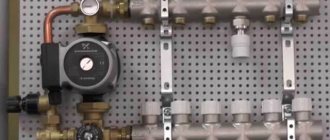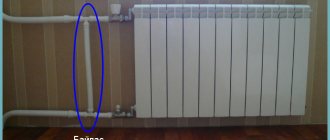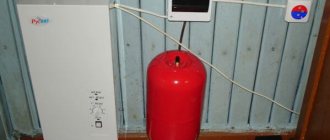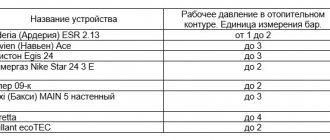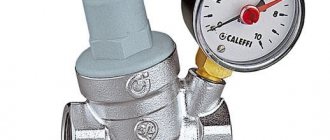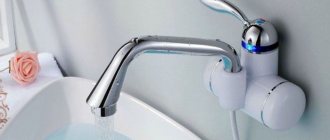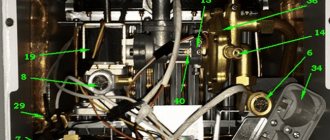When arranging the heating system of a private house, various auxiliary mechanisms and components are used. One of them is a three-way valve. Its task is to redistribute the flow of hot water in the heating system to prevent water hammer or damage to important equipment. The operating principle of a three-way valve and its purpose are of interest to many homeowners.
A three-way valve is one of the auxiliary mechanisms for the heating system in the house
general information
It is no secret that the problem of uneven heat distribution in a room often causes a lot of trouble for owners. To get rid of this unpleasant phenomenon and create a comfortable temperature regime, you need to introduce a special device into the heating system - a thermal power regulator or a three-way valve.
The mechanism ensures recirculation of the coolant fluid by mixing a certain amount of cooled treatment with the main current. Currently, tees are installed in hot water supply systems, heating circuits and plumbing systems.
Three-way valve – multifunctional, durable
In most cases, three-way valves are installed in heating systems with many components and circuits, which is necessary to stabilize the temperature in all radiators. The use of the device allows you to control the flow of coolant, distributing it to different parts of the room (for example, in the kitchen, garage and living rooms). Among the main advantages of the invention are:
- compact and ergonomic dimensions;
- multifunctionality;
- ease of installation, operation and maintenance;
- high tightness;
- long service life;
- ease of switching between operating modes.
In addition to the advantages, tees also have disadvantages. These include the likelihood of valve jamming if operating rules are not followed and rapid wear of inexpensive products.
This video will tell you how to install a three-way valve correctly:
Design features
The faucet looks like a tee with a T-shaped arrangement of tubes. For this reason, plumbers began to call it a tee. As for the design of the mechanism, it includes:
- A sealed metal case that is reliably protected from moisture penetration, corrosive processes and other negative influences. The material used to make the body is cast iron, bronze, steel or brass.
- A valve with several passage channels of different shapes.
- Three openings (outlet, with hot and cold water supply).
Three-way valves may differ in some additional characteristics
The tee may also differ in a number of additional properties, which are indicated on its packaging. Depending on the type of shutter mounted in the mechanism, conical, cylindrical or spherical products are distinguished. The fastening principle can be flanged, coupling, welded or end-fitting. The mechanism is controlled manually, by a drive system or by an electronic controller. As for the shape of the plug, it comes in three types - S, T, L.
Principle of operation
To start the mechanism, you need to connect two pipes for supplying cold and hot water. To successfully connect, you should study the diagram of a three-way valve, which shows various arrows and guides. The hot water that comes from the boiler is the main coolant, and the cold water is the remaining waste.
Systems may differ in position and method
Between both openings with inlets to the flows there is a valve that regulates the water supply. Depending on the position and connection method, the system can:
- mix two streams of water into one;
- divide one line into two outputs.
Many people mistakenly think that the tee blocks the water channels that are connected to it, but this is not the case. The purpose of the mechanism is only to redirect the fluid from inlet to outlet.
In a simple configuration, the radiator is connected to the boiler in a series or parallel manner. It is impossible to adjust each element individually, since only the temperature of the liquid in the boiler tank changes.
If there is a desire to regulate each battery, the system must be equipped with a bypass, as well as a regulating needle valve, which will allow you to regulate the volume of liquid passing through it.
The purpose of the bypass is to maintain the overall resistance of the installation to prevent malfunction of the pump. Unfortunately, this approach is expensive and complex to install, so it is not very popular.
Operating efficiency and final efficiency indicators may depend on the location of the valve. If it is half open, then the outgoing water flow will have an average temperature. If the valve is fully open, the temperature will reach its maximum. When it is completely closed, only cold water flows out.
Design and operating principle
The three-way control valve structurally consists of the following elements:
- metal case;
- a gate in which there are passage channels;
- 3 pipes. Two of them are intended for connecting cold and hot water, and the third is for coolant outlet (depending on the type of tap, the purpose of the pipes may differ).
The operating principle of a three-way valve in a heating system is as follows. It is assumed that liquids from the heating boiler and from the return are supplied to the distribution valve. Depending on the position of the tap, coolant of different temperatures will pass through it:
Design and principle of operation of a three-way valve
- When the tap is fully open, hot coolant will flow to the heating radiators. Its temperature will correspond to the temperature in the boiler.
- When the tap is completely closed, cooled water from the return line will be supplied to the radiators.
- If you set the shutter to some intermediate position, the water will mix. This way you can regulate its temperature.
Automatic valves
It was mentioned above that 3-way valves can be operated manually using a stem, which is located on one side of the valve and is equipped with a turning handle or nut. But this method of control is not entirely convenient.
As you know, the power of the heating circuit is adjusted taking into account the return temperature , so the manual method can only determine the proportion of mixing water with different lines. Changing the final temperature may take too long, and the distribution of thermal potential is uneven.
Because of this feature, automatic valves that operate on the basis of servo drives or special hydrodynamic and pneumatic heads have recently become very popular. These elements are capable of instantly changing the current three-way valve configurations, taking into account the outlet temperature.
Automatic valves are easy to use, therefore they are more popular than manual ones.
According to the principle of operation, the electric drive is similar to manual control, but it operates without human intervention, but on the basis of an electronic control unit. The unit itself is a power unit that rotates the rod and changes its position taking into account the signal.
Almost all three-way valves support the installation of a servo drive, but it is advisable to buy special designs that are small in size and designed for electric drives.
After receiving the required values, a signal to action is sent to the servo drive, then it begins to change the location of the rod or rotate the ball inside the tee. Uninterrupted and high-quality operation of the system is ensured by the operation of the electronic control unit. The absence of this node makes the installation useless.
Servo drives have many advantages. Their main advantage is the ability to automate the entire operation of the heating system and deprive yourself of additional hassle. If you connect a node with a Smart Home system, this will also allow you to control the heating directly from your smartphone.
Automatic valves with electric drive
To maintain a stable temperature in the house, periodic adjustment of the position of the three-way valve is required due to changes in outside temperature. The control can be automated if you connect it to a controller capable of issuing control signals when the air temperature changes.
The crane is directly controlled using an electric servo drive. It is installed on a rod or on an axle in the case of a ball model. Installation of the servo drive is possible on almost any three-way valve. However, for automated heating systems, it is more advisable to use three-way valves, which were originally designed for the installation of a servo drive. This will simplify installation and make the entire structure more compact.
Areas of application
Modern valves are in wide demand and are actively used in various areas of human activity. They are often installed in modern heating mains, which require constant adjustment of proportions when mixing different coolant flows. For such purposes, it is customary to use electromagnetic devices or models with a thermal head.
As for domestic use, in this case it is enough to purchase a thermostatic mixing device that will allow you to regulate the temperature of the coolant. It is supplied both to the underfloor heating piping system and to heating radiators. And if the household device is equipped with automatic control, then changing the temperature in the room will be much easier.
The use of a three-way valve in a heating system is profitable and economical
It should be noted that using a tee in a heating system to balance possible temperature surges is not only beneficial, but also economical. The device allows you to reduce the volume of fuel consumed several times, while the final efficiency indicators of the system will increase noticeably. In some rooms, the presence of such a device is simply necessary. For example, if a heated floor is installed in the house, then the device will prevent excessive heating of the floor covering.
Purpose and areas of use
Three-way valves are used in the following areas:
- In main heating networks. Using the device, a certain amount from the return circuit is added to the main coolant flow. This is done when you need to lower the temperature of the direct flow without changing the pressure and operating mode of the boiler. The taps are equipped with an electromagnetic drive or a temperature-sensitive sensor.
- In domestic heating systems. A thermostatic drive is used, by means of which the temperature of the coolant directed, for example, to “warm floor” equipment or to wall radiators is regulated. Installing a remote control module greatly simplifies climate control. Precise control of the fluid temperature in the return line can significantly reduce heating costs. This also helps to limit the maximum temperature of the heated floor, protecting it from overheating.
Figure 1. Diagram of connecting a three-way valve to the heating system
- For water supply when regulating water temperature. The most famous example is a regular mixer.
- For water treatment. To switch the water flow circuit bypassing the filter during service work, for example, replacing cartridges.
Three-way valves are also used in process pipelines, wherever it is necessary to temporarily or permanently redirect flows of liquids or gases, as well as mix such flows in certain proportions.
Buying a crane
When purchasing a three-way valve, you need to consider several features and selection criteria. First of all, you need to do the following:
- Measure the diameter of the pipes of the common line to which the tee will be connected. The optimal figures are 20-40 millimeters, but there are also non-standard situations when you have to purchase special adapters for an individual size.
- Understand the pipeline capacity in heating circuits. To do this, you need to carry out a simple calculation and determine how much liquid each pipe can pass through, as well as what period of time this process takes.
- Find out if it is possible to additionally connect a servo drive, which will make the system automatic. This option is especially in demand for rooms with heated floors.
When purchasing a 3 way valve, it is important to take some measurements
Also, when purchasing a tee, it would not hurt to carefully study its other characteristics. In most cases, they are indicated on the box with the product. If it is difficult for an inexperienced buyer to understand various terms and official data, then it is better for him to seek help from consultants.
Installation and operation
To ensure successful installation of a three-way valve, it is important to follow the drawings and step-by-step instructions. also need to pay attention to several nuances of the upcoming installation:
To properly install a three way valve, it is important to follow the drawings and step-by-step instructions
- On the body of the tee there is a special diagram with arrows that show in detail the direction of water flow. Its presence significantly simplifies installation work and allows you to quickly and accurately connect important components.
- When welding metal mechanisms, the temperature flow in the joint area must not be allowed to exceed +100 °C. It is important to ensure that scale or dirt does not penetrate the system, otherwise this can lead to irreparable consequences.
- To install the tee, you need to choose a place that will be easy to reach for repairs or maintenance. If the tap has to pass insufficiently high-quality liquid, it is recommended to additionally equip it with filter units.
- The method of fixing the product can be either vertical or horizontal. This does not affect work efficiency in any way. As for the valve, it is installed directly in front of the circulation pump.
In order for the tee to function for a long time, reliably and efficiently, it is necessary to take into account the operating rules and maintain it on time. The service life of the device depends on proper and correct use.
Features of installation and operation
To properly install a three-way valve, you should know several features:
- Refer to the diagram of arrows shown on the body. They indicate in which direction the water flow is moving.
- When welding during installation, do not allow the temperature flow at the joints to exceed 100 degrees. Make sure that no dirt or scale gets inside the device when welding.
- Choose a place for installation that can be easily reached if necessary.
- If the faucet will operate with low-quality coolant , additional filters will need to be installed.
- The product can be screwed either vertically or horizontally - this will not affect its performance.
- In a heating system, the valve is installed before the circulation pump.
The operation of the device must be observed in accordance with the rules established in the instructions. And all parts require periodic inspection and maintenance.
Proper and correct use of the device will extend its service life and will serve properly.
Useful tips
Before starting the heating system, you must make sure that the three-way valve and other components are in full working order, do not need repair or replacement, and also meet operational requirements. It is not recommended to install a tee on a pipeline with a pipe diameter of 40 millimeters or more. When operating in a hot environment, the valve must be opened with extreme caution, otherwise there is a risk of hydraulic valve failure.
The best material for a three-way valve is brass.
Experts recommend placing control devices or a turning handle with a rod so that they are freely accessible. When choosing a suitable faucet model, it is advisable to give preference to products made of brass. They are characterized by a long service life and resistance to all kinds of influences.
As for the control method, the best option would be a product with pneumatic control. Before making a choice and buying a tee, it is better to consult with a specialist, talk about the possible pros and cons of the available models, and also read reviews about them on thematic forums.
